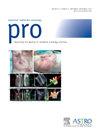化疗前磁共振模拟在评估高级别胶质瘤治疗反应和假性进展中的附加价值
IF 3.4
3区 医学
Q2 ONCOLOGY
引用次数: 0
摘要
背景:在高级别胶质瘤(HGG)患者的放射治疗(RT)计划中使用专用的磁共振成像模拟(MRsim)可以检测早期放射学变化,包括手术后和标准治疗化疗前的肿瘤进展。本研究旨在确定使用术后 MRI 与 MRsim 作为反应评估基线的影响,以及化疗后一个月(FU1)随访影像报告假性进展的影响。所有患者都接受了术后 MRI、MRsim 和每 2-3 个月一次的随访 MRI 扫描。当基线为术后 MRI 或 MRsim 时,肿瘤反应由三名独立的盲审者使用神经肿瘤学反应评估(RANO)标准进行评估。观察者之间的一致性采用光度卡帕计算:共纳入30名患者(中位年龄60.5岁;IQR 54.5-66.3)。手术与 RT 之间的中位间隔为 34 天(IQR 27-41)。当基线为术后 MRI 与 MRsim 时,17 名患者(57%)在 FU1 时的反应评估有所不同,包括 11 名患者(37%)的真正进展与部分反应(PR)或疾病稳定(SD),以及 6 名患者(20%)的 SD 与 PR。当基线为术后 MRI 时,19 名患者(63.3%)在 FU1 出现真正进展,而当基线为 MRsim 时,8 名患者(26.7%)出现真正进展(p=.004)。当基线为术后 MRI 与 MRsim 时,在 FU1 观察到假性进展的患者分别为 12 人(40%)和 4 人(13%)(p=.019)。观察者之间的一致性为中等(κ = 0.579; p结论:我们的研究表明,在HGG患者接近RT时获得最新的MR,对改善反应评估和评估假性进展的准确性很有价值,即使在RT后首次随访的早期时间点也是如此。更早地识别出真正进展的患者,就能更及时地进行挽救治疗,包括潜在的临床试验,以改善患者的预后。本文章由计算机程序翻译,如有差异,请以英文原文为准。
Additive Value of Magnetic Resonance Simulation Before Chemoradiation in Evaluating Treatment Response and Pseudoprogression in High-Grade Gliomas
Purpose
A dedicated magnetic resonance imaging simulation (MRsim) for radiation treatment (RT) planning in patients with high-grade glioma (HGG) can detect early radiologic changes, including tumor progression after surgery and before standard of care chemoradiation. This study aimed to determine the effect of using postoperative magnetic resonance imaging (MRI) versus MRsim as the baseline for response assessment and reporting pseudoprogression on follow-up imaging at 1 month (FU1) after chemoradiation.
Methods and Materials
Histologically confirmed patients with HGG were planned for 6 weeks of RT in a prospective study for adaptive RT planning. All patients underwent postoperative MRI, MRsim, and follow-up MRI scans every 2 to 3 months. Tumor response was assessed by 3 independent blinded reviewers using Response Assessment in Neuro-Oncology criteria when baseline was either postoperative MRI or MRsim. Interobserver agreement was calculated using Light's kappa.
Results
Thirty patients (median age, 60.5 years; IQR, 54.5-66.3) were included. Median interval between surgery and RT was 34 days (IQR, 27-41). Response assessment at FU1 differed in 17 patients (57%) when the baseline was postoperative MRI versus MRsim, including true progression versus partial response or stable disease in 11 (37%) and stable disease versus partial response in 6 (20%) patients. True progression was reported in 19 patients (63.3%) on FU1 when the baseline was postoperative MRI versus 8 patients (26.7%) when the baseline was MRsim (P = .004). Pseudoprogression was observed at FU1 in 12 (40%) versus 4 (13%) patients, when the baseline was postoperative MRI versus MRsim (P = .019). Interobserver agreement between observers was moderate (κ = 0.579; P < .001).
Conclusions
Our study demonstrates the value of acquiring an updated MR closer to RT in patients with HGG to improve response assessment, and accuracy in evaluation of pseudoprogression even at the early time point of first follow-up after RT. Earlier identification of patients with true progression would enable more timely salvage treatments including potential clinical trial enrollment to improve patient outcomes.
求助全文
通过发布文献求助,成功后即可免费获取论文全文。
去求助
来源期刊

Practical Radiation Oncology
Medicine-Radiology, Nuclear Medicine and Imaging
CiteScore
5.20
自引率
6.10%
发文量
177
审稿时长
34 days
期刊介绍:
The overarching mission of Practical Radiation Oncology is to improve the quality of radiation oncology practice. PRO''s purpose is to document the state of current practice, providing background for those in training and continuing education for practitioners, through discussion and illustration of new techniques, evaluation of current practices, and publication of case reports. PRO strives to provide its readers content that emphasizes knowledge "with a purpose." The content of PRO includes:
Original articles focusing on patient safety, quality measurement, or quality improvement initiatives
Original articles focusing on imaging, contouring, target delineation, simulation, treatment planning, immobilization, organ motion, and other practical issues
ASTRO guidelines, position papers, and consensus statements
Essays that highlight enriching personal experiences in caring for cancer patients and their families.
 求助内容:
求助内容: 应助结果提醒方式:
应助结果提醒方式:


